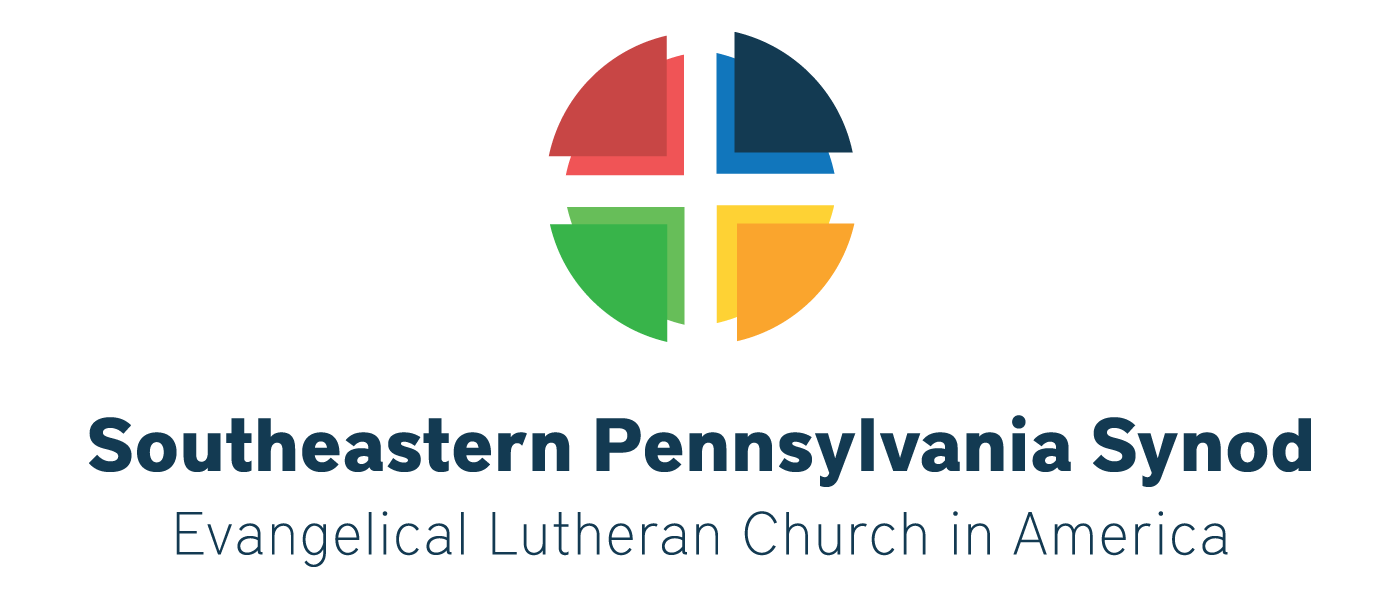September 29, 2016 in Congregations
A Tribute to Historic St. Michael’s
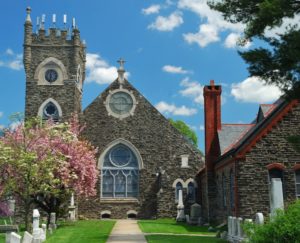
Parishoners, pastors and friends, past and present, of St. Michael’s in Germantown gathered Sept. 11 to say farewell and celebrate 288 years of faithful ministry. The congregation is likely older, with Lutheran services held on Germantown Avenue in the 1690s. Many soldiers of the Revolution are buried in its graveyard. St. Michael’s also birthed or supported a number of new congregations in Chestnut Hill and eastern Montgomery County and sent a number of sons and daughters into the ordained ministry.
From the founding of a Women’s Missionary Society in its early days to its current Community Meal and ministry with people living with economic poverty, food insecurity and homelessness, “St. Michael’s has always pointed us to Christ,” Bishop Claire Burkat said in the final sermon in the church.
This page contains some photographs of the closing worship by John Kahler, along with highlights from Bishop Burkat’s sermon and a brief history by Synod Archivist Kim-Eric Williams.

Highlights of Bishop Burkat’s Sermon
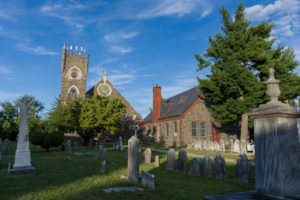 Maybe you wouldn’t expect the working class and frugal German Lutherans who settled in Germantown in 1728 to name their small but growing church after the one of the most famous angels of all – Michael. …
Maybe you wouldn’t expect the working class and frugal German Lutherans who settled in Germantown in 1728 to name their small but growing church after the one of the most famous angels of all – Michael. …
It is no small thing to have a church with God’s five-star general as your namesake. This congregation is one of the oldest Lutheran Churches in America, founder of the predecessor body that is now today the Evangelical Lutheran Church in America.
In a way, we are all part of that army of angels. …
As Christians, we carry God’s message of love and fierce protection of the weak into the world. This is what the congregation of St. Michael’s has done for nearly 300 years.
When the children of poor families could not pay to educate their children, St. Michael’s is where they received their learning through Sunday School.
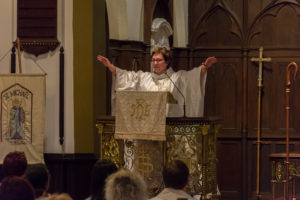 When women had little access to influence or power in the early days of this country, they banded together in this church to form a Women’s Missionary Society and worked tirelessly to make sure that not only the young people were educated, but that candidates for ministry were lifted up from within the congregation. …
When women had little access to influence or power in the early days of this country, they banded together in this church to form a Women’s Missionary Society and worked tirelessly to make sure that not only the young people were educated, but that candidates for ministry were lifted up from within the congregation. …
All four recent pastors are champions of the poor and marginalized. I can imagine those colonial women in their petticoats and prim hats would be proud to know that almost three hundred years later, the pastors and people of this congregation are still ministering to the people living in poverty, people who are food insecure, people living with homelessness, people living with HIV and AIDS, and people who were formerly incarcerated living with hopes for a second chance and fresh start. …
But there’s a deeper meaning to this name St. Michael’s. The name Michael literally means, “Who is like God?” … The obvious answer is: No one! No one is like God! But for Christians, there is another answer: Jesus.
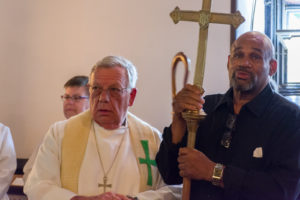 St. Michael’s has answered the question embedded within its very name for nearly 300 years by pointing to Jesus Christ. From the very first Lutherans who yearned for the worship services of the lands they left behind in Europe; to the seminarians who sat at the feet of pastors and parishioners as they apprenticed for the ministry; to the thousands of hungry folk who have come here looking to be fed through Community Meal – St Michael’s has always pointed us to Christ. …
St. Michael’s has answered the question embedded within its very name for nearly 300 years by pointing to Jesus Christ. From the very first Lutherans who yearned for the worship services of the lands they left behind in Europe; to the seminarians who sat at the feet of pastors and parishioners as they apprenticed for the ministry; to the thousands of hungry folk who have come here looking to be fed through Community Meal – St Michael’s has always pointed us to Christ. …
God is not finished yet. This congregation may have reached the end of its life – a life we celebrate and honor and whose passing we grieve. But we preach a God of resurrection through Jesus Christ who is the Lord of Life, and conqueror of death.
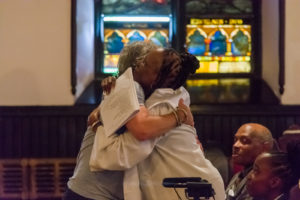 Who knows what God may have in store for this place? Who knows how the Spirit may yet move within these stones? …
Who knows what God may have in store for this place? Who knows how the Spirit may yet move within these stones? …
The congregations that welcome you (the last of the members of St Michael’s) as new members will be eager for the gifts of ministry you bring, for the memories that accompany you, for the question you bring with you: Who is like God?
Keep asking that question. Because the answers will lead you, will lead these stones, these angels, to the God who was, who is now, and who will be forevermore. Amen.
From the Archives:
A Brief History of St. Michael’s
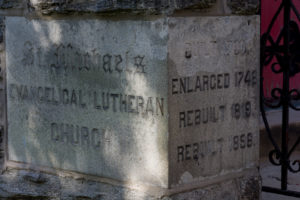 No one knows how old this famous congregation really is. We do know that there were Lutheran services here in the 1690’s and that the first pastor, Anthony Jacob Henkel died in 1728. Although his parish register is lost, he no doubt began ministry here at least 10 years earlier. The congregation is in its third building on the present site and it includes a three-story parsonage built in 1855, school house erected in 1740, a stone parish hall from 1893 and a large stone church from 1897.
No one knows how old this famous congregation really is. We do know that there were Lutheran services here in the 1690’s and that the first pastor, Anthony Jacob Henkel died in 1728. Although his parish register is lost, he no doubt began ministry here at least 10 years earlier. The congregation is in its third building on the present site and it includes a three-story parsonage built in 1855, school house erected in 1740, a stone parish hall from 1893 and a large stone church from 1897.
The property fronting on Germanton Avenue includes a whole city block and a large cemetery. Pastor Henkel is buried here along with Christopher Ludwick, the baker for the Continental army. Among the 700 burials recorded are soldiers from the Revolution and Major James Witherspoon, son of the president of Princeton University, the Rev. John Witherspoon.
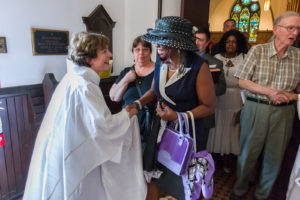 The congregation was not one of those who called Henry Melchior Muhlenberg but soon found itself allied with the Ministerium of Pennsylvania. In fact a major conflict in 1762 called upon Muhlenberg and Dean Carl Magnus Wrangel to write up a constitution for the congregation that became a model for all other Lutheran church organizations.
The congregation was not one of those who called Henry Melchior Muhlenberg but soon found itself allied with the Ministerium of Pennsylvania. In fact a major conflict in 1762 called upon Muhlenberg and Dean Carl Magnus Wrangel to write up a constitution for the congregation that became a model for all other Lutheran church organizations.
The congregation was active not only in serving its own members but in supporting the founding and supporting of many other congregations. Its sharing with St. Peter’s in Barren (Lafayette) Hill lasted 60 years and its resources were seen in Christ, Chestnut Hill, Zion, Whitemarsh/Flourtown, and in Center Square and Upper Dublin.
In 1859 the Lutheran Orphanage of Germantown was founded by the wife of St. Michael’s pastor, Elizabeth Fry Ashmead Schaeffer. This institution later became a home for senior citizens and inspired many church efforts to serve peoples’ needs.
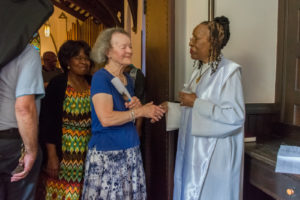 Because of its proximity to the Lutheran Seminary it had a close connection with Seminary faculty, including Luther D. Reed, Charles Siegel and recently Philip Krey.
Because of its proximity to the Lutheran Seminary it had a close connection with Seminary faculty, including Luther D. Reed, Charles Siegel and recently Philip Krey.
While there is a record of the Baptism of an African American in 1752, the congregation only became biracial in the 1960’s as the neighborhood changed. It continued to minister to a diverse community until this year when its numbers had so decreased that the maintenance costs were exceeding the ability of the congregation to keep up and plan on outreach. Prayers for the Synod Council and Bishop are requested so that a plan may emerge so that the location and the facilities may again serve the Gospel.
— Kim-Eric Williams, Synod Archivist
